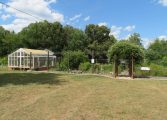By Page H. Gifford
Correspondent
The Lake Monticello Wildlife Committee kicked off its informative sessions on March 3 on wildlife with bears and how to protect them and live with them.
The committee has been tasked with educating the community on living with, understanding, and enjoying wildlife while decreasing problems they may cause.
Sharon Cole and Jack Day, master naturalists with the Department of Wildlife Resources led the discussion.
“Sixty percent of Virginians did not know black bears are native to Virginia,” said Cole. “Since 1607 there was statewide hunting of them. They have been a gaming species since the 1930s and there are regulations governing harvesting and habitat.”
Since wildlife habitats have been shrinking steadily within the last couple of decades due to an increase in building this has forced wildlife to adapt in populated areas. Wildlife would prefer the serenity of quiet areas but nowadays have no choice.
“We live in bear territory and the general idea is to keep them from being drawn to inappropriate areas,” said Day. Like any wild animal, bears forage for food to maintain their weight up to 500 pounds. Their diet is 75 percent vegetarian fruits and nuts including acorns, berries, and grapes with the other 25 percent made up of insects and small rodents.
“They are not good hunters but their sense of smell can help them detect something a mile away,” said Day. “They can gain an average of two pounds a day. A lot of acorns can double their body weight but if there is a shortage of acorns they may look elsewhere for their high-carb diet of 20,000 calories a day,” added Day.
The largest population of bears on the East Coast except for Delaware and Rhode Island, are concentrated in swamp areas and the mountains.
“The population has been managed,” said Cole. “Cultural Capacity for wildlife is how many can an area tolerate and Carrying Capacity is the stability of the wildlife population.” The DWR has a Conflict Management Program to help with wildlife issues.
“Deterrents such as electric fencing, paintballs or rubber buckshot can be used but there are simpler methods that work,” she said. “Relocation is not an option because bears are territorial and if another bear is relocated it can become an issue that causes the bear to return to its original habitat and get killed in the road.”
The issue with feeding bears or any wildlife is they will keep returning to be fed and this becomes a problem. Plus, it cannot be repeated enough that it is illegal to feed wildlife in Virginia in part because it could wreak havoc with their natural diet and cause health issues. Aside from bird feeders, bears will raid garbage cans, pet food left outside, grills, fruit and vegetable crops, bee hives, and livestock feed. Avoid leaving bird feeders out April through November when bears are active. Secure food, garbage, and recycling, and clean and store grills.
Most common problems have simple solutions and since bears learn to associate people with food this can cause damage around homes and campgrounds and taking precautions works is the best way not to encourage them.
“It is a mistake for backpackers to throw their backpack at a bear when it has food. That is just encouraging the bear,” said Cole. This prompted Day to talk about what we should do if we encounter a bear.
“Don’t run. A bear can run 35 miles per hour. Calmly leave the area and make noise so the bear knows you are there. They don’t like to be surprised. Bears are scared so don’t corner it, just leave it alone,” he added. If out hiking, carry bear spray and know how to use it, and don’t approach a bear. Also, keep dogs safe while out walking in the woods. Dogs and bears do not get along, so keep your dog on a leash. For more tips on staying safe in bear country, at home, outdoors, and with your dog, visit BearWise.org.
Bears can live 15 years but only a quarter of the cubs born live to adulthood. Mothers begin to hibernate from December to January and by spring give birth to one to two cubs. Mothers will defend cubs if cornered or threatened but often the cubs are secured up in a tree and the mother may hide nearby until whatever or whoever leaves the area.
For more information on bears visit dwr.virginia.gov/wildlife/bear



